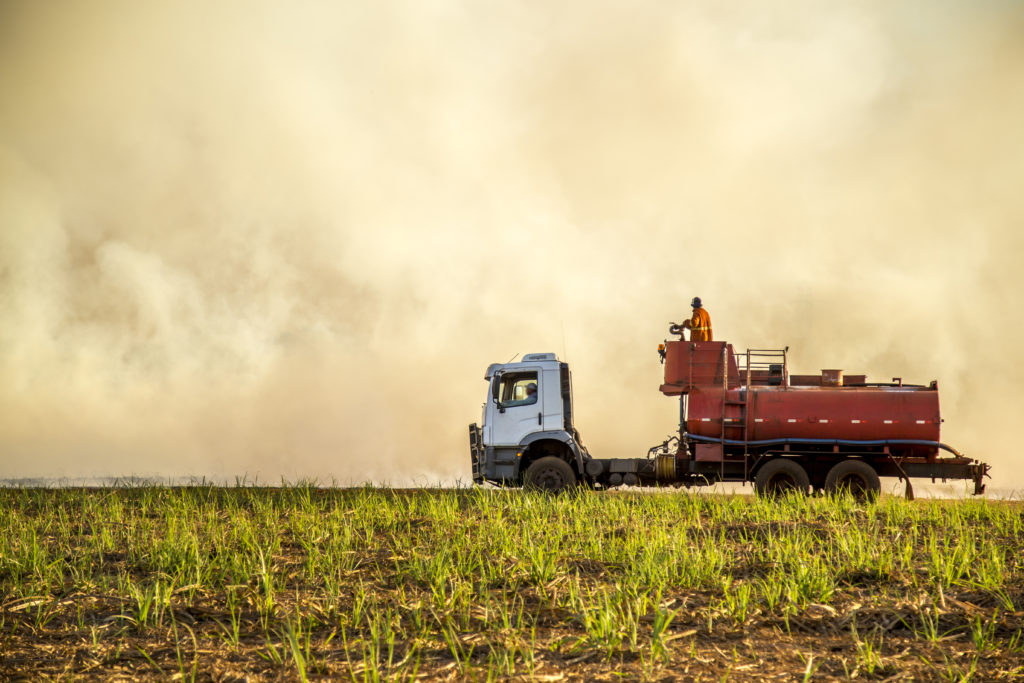If you’ve ever ventured into a cow pasture, chances are you’ve noticed an odour or two. What you’re likely smelling is methane and it’s more than just unpleasant. It’s a potent greenhouse gas. Molecule for molecule, methane has more than 80 times the global warming power of carbon dioxide.
A recent assessment from the United Nations Environment Programme (UNEP) and the Climate and Clean Air Coalition found that cutting farming-related methane emissions would be key in the battle against climate change. But how can the world do that? Read on for the answers.

Sugar cane Fire plantation undoing burned day
Where does methane come from?
Agriculture is the predominant source.
Livestock emissions – from manure and gastroenteric releases – account for roughly 32 per cent of human-caused methane emissions. Population growth, economic development and urban migration have stimulated unprecedented demand for animal protein and with the global population approaching 10 billion, this hunger is expected to increase by up to 70 per cent by 2050.
Agricultural methane doesn’t only come from animals, though. Paddy rice cultivation – in which flooded fields prevent oxygen from penetrating the soil, creating ideal conditions for methane-emitting bacteria – accounts for another 8 per cent of human-linked emissions.
What’s the big deal about methane?
Methane is the primary contributor to the formation of ground-level ozone, a hazardous air pollutant and greenhouse gas, exposure to which causes 1 million premature deaths every year. Methane is also a powerful greenhouse gas. Over a 20-year period, it is 80 times more potent at warming than carbon dioxide.
Methane has accounted for roughly 30 per cent of global warming since pre-industrial times and is proliferating faster than at any other time since record keeping began in the 1980s. In fact, according to data from the United States National Oceanic and Atmospheric Administration, even as carbon dioxideemissions decelerated during the pandemic-related lockdowns of 2020, atmospheric methane shot up.
How can we reduce methane emissions?
UNEP Food Systems and Agriculture Advisor James Lomax says the world needs to begin by “rethinking our approaches to agricultural cultivation and livestock production.” That includes leveraging new technology, shifting towards plant-rich diets and embracing alternative sources of protein. Lomax says that will be key if humanity is to slash greenhouse gas emissions and limit global warming to 1.5°C, a target of the Paris climate change agreement.

Can farmers help in the campaign to cut methane emissions?
Yes. They can provide animals with more nutritious feed so that they are larger, healthier and more productive, effectively producing more with less. Scientists are also experimenting with alternative types of feed to reduce the methane produced by cows and looking at ways to manage manure more efficiently by covering it, composting it, or using it to produce biogas.
When it comes to staple crops like paddy rice, experts recommend alternate wetting and drying approaches that could halve emissions. Rather than allowing the continuous flooding of fields, paddies could be irrigated and drained two to three times throughout the growing season, limiting methane production without impacting yield. That process would also require one-third less water, making it more economical.
Will reducing methane really help counter climate change?
Yes. Carbon dioxide remains in the atmosphere for hundreds to thousands of years. This means that even if emissions were immediately and dramatically reduced it would not have an effect on the climate until later in the century. But it takes only about a decade for methane to break down. So, reducing methane emissions now would have an impact in the near term and is critical for helping keep the world on a path to 1.5°C.
How much methane can we really cut?
Human-caused methane emissions could be reduced by as much as 45 per cent within the decade. This would avert nearly 0.3°C of global warming by 2045, helping to limit global temperature rise to 1.5˚C and putting the planet on track to achieve the Paris Agreement targets. Every year, the subsequent reduction in ground-level ozone would also prevent 260,000 premature deaths, 775,000 asthma-related hospital visits, 73 billion hours of lost labour from extreme heat and 25 million tonnes of crop losses.
What is the United Nations doing to help limit methane emissions?
A lot. UN Secretary-General António Guterres will convene the UN Food Systems Summit in September 2021, which aims to help make farming and food production more environmentally friendly.
In the meantime, the UN’s Koronivia Joint Work on Agriculture initiative is supporting the transformation of agricultural and food systems, focusing on how to maintain productivity amid a changing climate. Representatives are also working to mainstream agriculture into the UN Framework Convention on Climate Change and will hold discussions at the UN Climate Change Conference (COP26), later this year.
Every year, on 7 September, the world celebrates the International Day of Clean Air for Blue Skies. The day aims to raise awareness and facilitate actions to improve air quality. It is a global call to find new ways of doing things, to reduce the amount of air pollution we cause, and ensure that everyone, everywhere can enjoy their right to breathe clean air. The theme of the second annual International Day of Clear Air for blue skies, facilitated by the United Nations Environment Programme (UNEP), is “Healthy Air, Healthy Planet.”